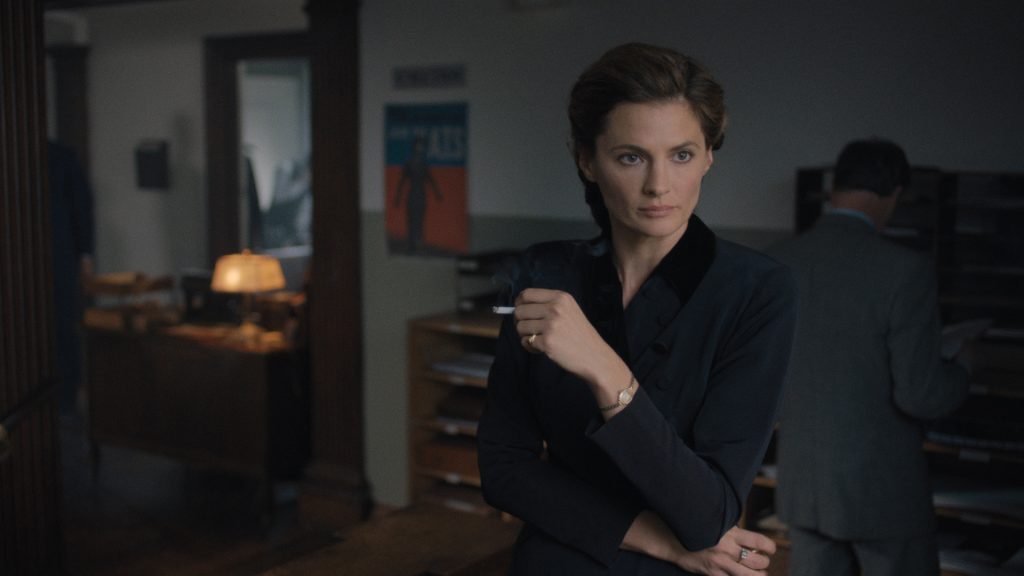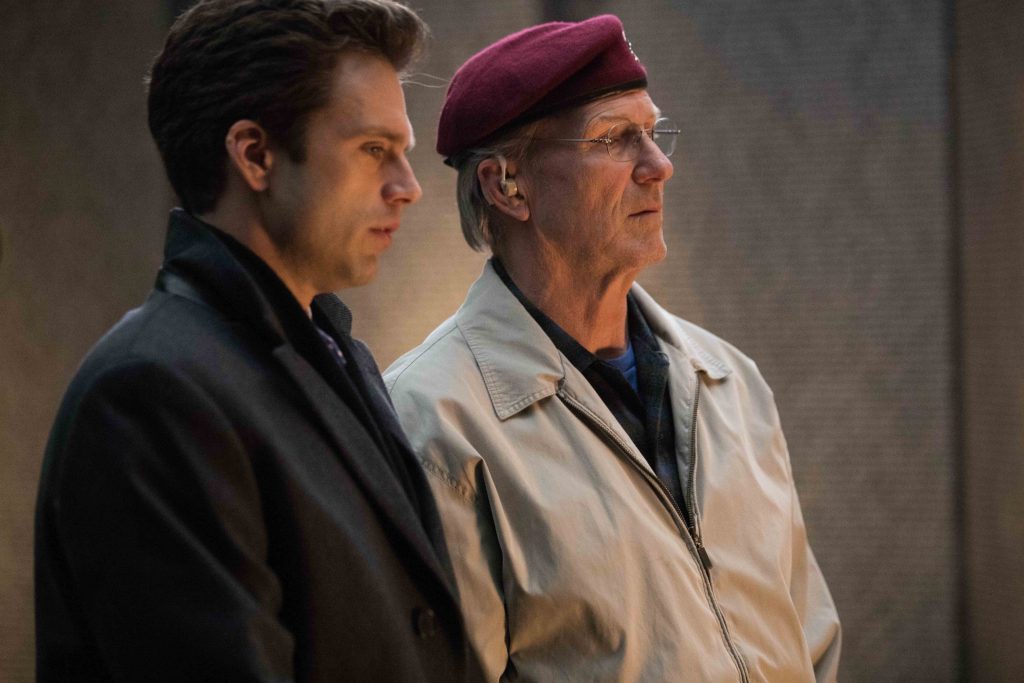November 20, 2020
by Carla Hay

Directed by Lydia Dean Pilcher
Some language in French with subtitles
Culture Representation: Taking place in the United Kingdom and France during World War II, the dramatic film “A Call to Spy,” which is inspired by a true story, features an almost all-white cast of characters (with one Indian) representing the middle-class, working-class and wealthy.
Culture Clash: A United Kingdom-based government operation recruits women to become spies in Nazi-occupied France.
Culture Audience: “A Call to Spy” will appeal primarily to people who are interested in real-life World War II stories that don’t get much attention, but the formulaic plot and slow pace of the movie are detriments to the movie’s overall inspiring message.

The dramatic film “A Call to Spy,” which is based on real events, has its heart in the right place, but the movie is a little too cookie-cutter and by-the-numbers predictable for it to be considered a great movie. However, “A Call to Spy” (directed by Lydia Dean Pilcher) has enough merit because it tells a noble story that’s never been told before in a movie: how women during World War II volunteered to become spies for the Allied Forces by going into Nazi-occupied France and helping the French Resistance movement. The spy program was created by Special Operations Executive (SOE), a secret group formed by the British government in 1940.
“A Call to Spy” was written and produced by Sarah Megan Thomas, who also stars as Virginia Hall, the story’s main heroine and the only American character in the film. Virginia has a prosthetic leg below the knee, and her leg disability is why she’s been rejected several times to work as a diplomat for the United States Foreign Service. It’s not shown in the movie, but the real-life Virginia Hall was an ambulance driver in France and lived for a while in Spain before she was recruited in 1941 to work for SOE.
Although Thomas is not a bad actress, it’s easy to see that she financed this movie so she could showcase herself. And there’s nothing wrong with that if the quality of the film is what the subject matter deserves. When someone is the producer, writer and star of a movie, that person might not be willing to take constructive criticism to improve the project.
A more objective producer probably would have been able to do something to improve the movie’s obvious flaws, particularly the over-simplistic screenplay that doesn’t properly acknowledge some of war’s harsh realities. And it isn’t until the film’s epilogue that it’s mentioned how high the mortality rate was (about 33%) for the women in this spy program who died while in service.
“A Call to Spy” focuses on three women who are part of this SOE spy program: Virginia Hall, who is the movie’s pluckiest, bravest and most resourceful heroine; SOE “spymistress” Vera Atkins (played by Stana Katic), who personally recruits many of the women spies and does mostly office work in London; and Noor Inayat Khan (played by Radhika Apte), whose family background is inexplicably changed for this movie. In “A Call to Spy,” Noor is described as an “Indian princess” whose father comes from Indian royalty and whose white mother is American. In real life, Noor Inayat Khan did have an Indian father and a white American mother, but her father was a musician who wasn’t part of Indian royalty.
The idea to recruit women spies came about because women wouldn’t be considered as suspicious as men. “A Call to Spy” has a prologue explaining that in the British government’s mission to help the French Resistance by having spies infiltrate Nazi-occupied France, “there were no experienced spies for this type of warfare.” Therefore, “amateurs” had to be recruited. A lot of the women were “wireless” operatives, since one of their chief responsibilities was using telegraphs to wire information that they received.
Vera’s supervisor at SOE’s F section in London is Colonel Maurice Buckmaster (played by Linus Roache), who is written and portrayed as an enlightened man who was way ahead of his time because he doesn’t have a problem with a woman being in charge of this important recruitment process. Maurice also knows a big secret about Vera: She and her mother are Jewish refugees, and they are not British citizens. Maurice tells Vera that her secret is safe with him. Meanwhile, Vera has been applying for British citizenship but has been rejected multiple times.
During Virginia’s spy activities in France, she makes an ally in a French physician named Doctor Chevain (played by Rossif Sutherland), who helps hide and give medical treatment to Jewish people and people involved in the French Resistance. Meanwhile, Noor is embedded as a servant in the house of a French Nazi, and she’s taken the alias Madeline. The movie’s sometimes slow pace begins to pick up when it actually shows these spies at work. The best parts of the movie are how they navigate the intrigue and secrecy of taking on a new identity while fulfilling their duties to get valuable information to send to the British government.
Unfortunately, too much of “A Call to Spy” has very “TV movie of the week” characteristics instead of being a powerful and immersive cinema experience. And that doesn’t mean that the movie needed a larger budget. The film’s screenplay often does a disservice to its intent of being a historical film, because it downplays or erases too many of the horrible-but-realistic aspects of war. It’s almost as if the filmmakers were thinking, “Women are probably the target audience for this movie. Therefore, we can’t put anything in the movie that’s too realistic because it would be too disturbing to the target audience.”
For example, this is a movie about female spies, but nowhere does the movie acknowledge that sexual violence is a part of war. It’s as if the filmmakers want viewers to think that people during World War II didn’t experience these atrocities. And that doesn’t mean that rape had to be shown in the movie. But the movie doesn’t even mention that rape and other sexual assault were real risks that these female spies had to consider or experienced while they were doing this dangerous work.
As part of their training, the female spies are told to not get emotionally involved with anyone they meet while performing their spy duties. And the movie shows a little bit of their self-defense training, where Virginia is taught how to slice someone with a knife while ambushing from behind. And because they train alongside men, the movie predictably show some of the sexist reactions they get from some of their male colleagues.
But the movie fails to acknowledge a major gender difference in espionage training: Female spies, then and now, are taught that they can use their sexuality in order to get what they want. It’s understandable that the filmmakers of this movie did not want to depict the sexuality aspect of spying (there’s no sex or romance in the movie), but it seems like they also wanted to shield the audience from this reality.
The women spies don’t need to have any sexual encounters in this movie for it to be realistic. But in trying too hard to present the women spies as saintly and practically asexual heroes, “A Call to Spy” gives the women spies a “too good to be true” sheen that at times looks unrealistic. However, it’s admirable how the movie depicts the friendships and loyalties that develop among these colleagues.
The movie has questionable portrayals of what happens when spies are captured by the enemy. There’s a scene near the beginning of the film where Virginia is captured and goes through water torture, but when things go wrong for Virginia, things work out just a little too smoothly for her. There’s a scene later in the movie where Virginia is mistakenly assigned to walk through brutal winter snow in the Pyrenees to go to a particular destination, but it’s really a trap that was set by the Nazis. But how she was able to avoid this trap is never fully explained because she’s next seen safe and sound, having a meeting with SOE officials.
There are some SOE men in the movie who are blatantly sexist, but they are written as minor characters that make rude comments and don’t really try to actively sabotage Vera or take her power away. For example, one of these sexist male colleagues tells Vera about her recruitment of female spies: “Miss Atkins, make sure they’re pretty.” Vera quips in response: “For you or the spies?”
The Nazis are obviously portrayed as the villains, so the movie shows the worst derogatory comments and violence coming from the Nazis. However, as much as the movie wants to make a big deal out of these spies being women, it also glosses over how these unmarried, attractive women (especially Virginia and Noor, who are actually in France doing the spying, while Vera basically has an office job in England) would be used and abused in this line of work, sometimes from people who are supposed to be on their side.
There’s a little bit of tokenism to the Noor character, since the movie never really delves into her perspective of how she must have felt being a woman of color sent to spy in Nazi territory. When it comes to any bigotry barriers that these women face, other than gender discrimination, “A Call to Spy” gives Virginia’s prosthetic leg much more empathy than Noor’s skin color as an “impediment” that makes them the target of prejudice. However, when it suits her, Virginia can and does hide the fact that she has a prosthetic leg, whereas Noor cannot hide her skin color.
The character of Vera comes closest to being written as a human being with vulnerabilities, such as self-doubt and impatience. She doesn’t pretend to have all the answers, nor does she try to be a feminist superwoman, because she often defers to her boss Maurice to make big decisions. Virginia and Noor are portrayed with almost no personality flaws and are completely focused on their work, whereas Vera has more of a realistic emotional story arc.
All of the cast members do adequate jobs of portraying their characters, but there’s really nothing outstanding about their performances. The movie, which was actually filmed in Pennsylvania and Hungary, has better costume design than it does production design. All of the other production elements are fine, but not award-worthy. “A Call to Spy” is worth seeing for a portrayal of World War II female espionage that’s not really taught in history classes. However, the movie gives the impression that people would be better off reading non-fiction books to get a sense of who these women really were.
IFC Films released “A Call to Spy” in select U.S. cinemas, digital and VOD on October 2, 2020. The movie’s U.K. release was on October 23, 2020.


